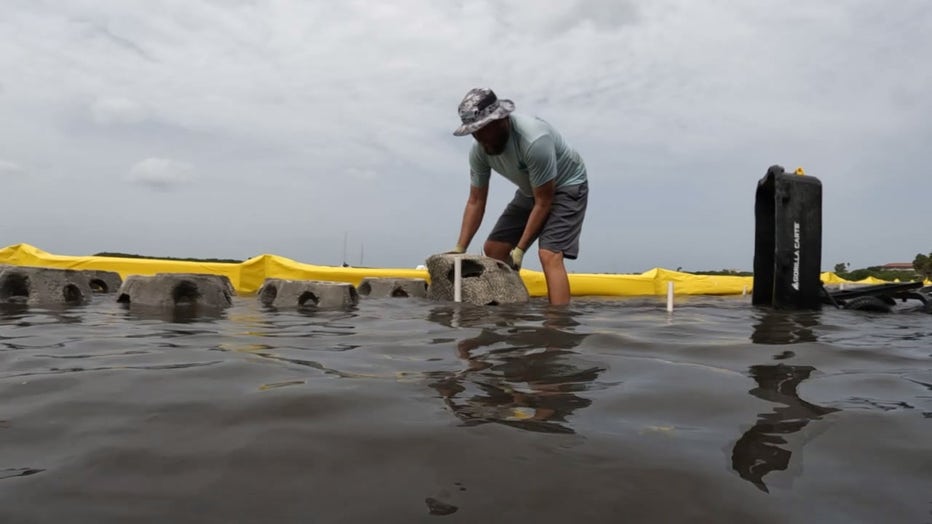Oyster reef balls installed along Maximo Park's southern shoreline in restoration project

Shoreline restoration project begins
In some parts of the Bay Area, it?s no secret that the shoreline is getting smaller and smaller. But, the city of St. Petersburg and Tampa Bay Watch have a plan to slow the erosion in one of the city?s waterfront parks.
ST. PETERSBURG, Fla. - Lifting 150-pound pieces of concrete in 90-degree heat isn’t for the faint of heart.
"It’s a pretty good CrossFit experience out here," Eric Plage, the Oyster Reef Ball Program Coordinator at Tampa Bay Watch, said.
The reason for it, though, makes the workout worth it.
READ: Researchers hope Honduran coral could help Florida's threatened reefs
"We putting oyster reef balls, or artificial reef balls, in the water, 600 over the course of three days, to be shoreline stabilization, to create biological filtration and to create oyster communities along this eroding shoreline," Plage said.

Volunteers with Tampa Bay Watch and the City of St. Petersburg installed shell bags along with the oyster reef balls along the southern shoreline of Maximo Park on Wednesday. The oyster reef balls are made out of marine-friendly concrete that have additives that make them more pH neutral compared to regular concrete, Plage said.
They’re creating a living shoreline that will be almost 8,000 square feet.
"There's been a lot of scouring over the years from boat wakes, winds, storms, tides, and it undercuts the trees behind us, the habitat behind us, and slowly kind of eats away the park," Plage said.
MORE: Dozens of balloons collected off Sarasota coast, researchers warn of plastic pollution danger
The goal is to ease erosion, protect cultural artifacts in the park, restore coastal habitats and enhance water quality in the area.
"The city identified this project as a priority when we began to see some substantial erosion on the shoreline, that erosion was impacting the recreational space that people could enjoy," said Barbara Stalbird, the assistant director of St. Pete’s Parks and Recreation Department. "It was also impacting the artifacts which lie upland of the shoreline."

They said the reef balls are a good alternative to seawalls that don’t allow for different habitats like the reef balls do.
"By putting the reef balls in the oyster shell bags and later coming in with the plants and the dune system, you can create a natural shoreline and save your park," Plage said.
According to Stalbird, $330,000 in grants from the Department of Environmental Protection and the Tampa Bay Estuary Program paid for the project. She said they recently did a similar project at Lassing Park and said it’s already working.
READ: Florida leaders approved $300M to protect thousands of acres of green space across the state
Volunteers will be back on Thursday to finish laying the rest of the oyster reef balls and the shell bags. They’ll come back in August to put plants along the reef balls to create a strong, dune-type shoreline.
Plage said volunteers can sign up for the August event on Tampa Bay Watch’s website.
WATCH FOX 13 NEWS:
SIGN UP: Click here to sign up for the FOX 13 daily newsletter

